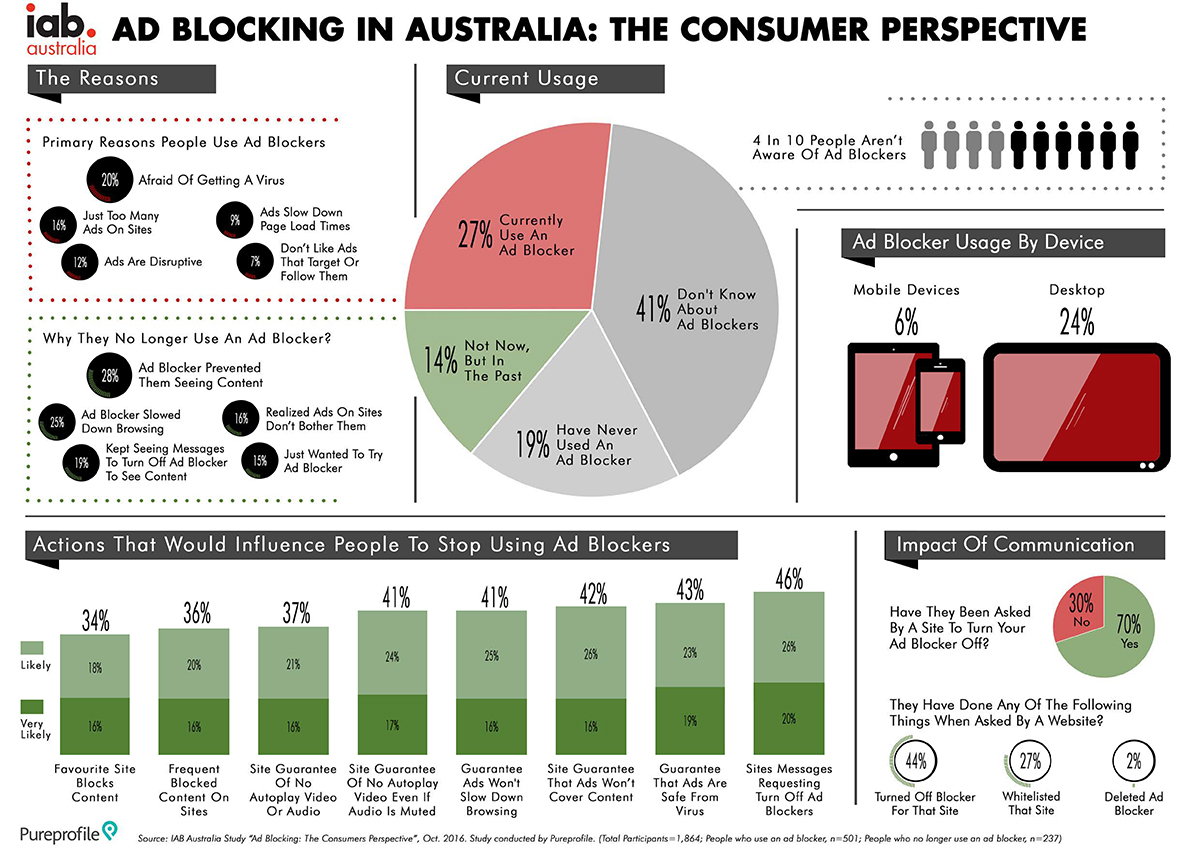Almost 30% of Australian consumers are now using ad blocking technology on one of their devices according to a new study released today by IAB Australia and conducted by Pureprofile. According to the IAB AdBlocking in Australia study, a fear of viruses and malware is the most common reason for installing the software (20 percent of respondents), but 16 percent of respondents reported that they had installed the ad blocker because they felt there were too many ads on sites. The study also found Ad blockers are used primarily on desktops and laptops, with only 6 percent of people having ad blockers on mobile devices.
The research was conducted by IAB’s Adblocking Taskforce to gain a clear understanding of how and why ad blockers are being used in the Australian market. The study will be replicated every six months.
The study found that many consumers are open to modifying their ad-blocking habits with the right communication from websites and identified four ways to encourage consumers to stop using ad blockers:
• Assure users of site safety: Provide guarantees that site and ads are secure, malware- and virus-free, and won’t slow down browsing.
• Focus on ads that limit interruption of content flow and do not take an excessive amount of time to load.
• Polite messaging to turn off their ad blocker or whitelist a site in exchange for viewing content.
• Some sites may choose to limit content availability for users of ad blockers who do not turn off their blockers. IAB Australia members have access to an Ad Block Detection Code to help provide better communication with site visitors about ad blocking and to get a more consistent understanding of the scope of ad blocker usage.
The Adblocking Taskforce is now working on Guidelines and a program that address the four recommendations, as well as general market education activities for consumers, media and creative agencies.
According to IAB CEO Vijay Solanki, the results have highlighted the key areas for the industry to address.
“As an industry it’s vital that we continue to evolve and improve ad experiences for consumers, drawing on the LEAN ad principles to produce lighter, more relevant and quality creative. We also need to educate consumers on the safety of ad supported sites as there is clearly some confusion about advertising delivering viruses simply because many ad blocking tools are packaged with anti-virus software. Finally we need to educate consumers about the value exchange that can be offered by ads, allowing them access to content,” said Solanki.
Other findings from the study include:
- Four out of ten Australian don’t know about ad blockers
- 7 in 10 people have been asked by a site to turn off their ad blocker to gain access to content; of these 62 percent have taken an action after a site request (turned off or deleted blocker, whitelisted site)
- 14 percent of those who do not currently use ad blockers have used one in the past
- The actions that will best influence consumers to stop using ad blockers include:
o Site messaging asking them to turn off their ad blocker (46 percent)
o Favourite site blocked content (34 percent)
o Frequent blocked content on site (36 percent)
o Guarantee from sites that ads:
§ Are safe from viruses (43 percent)
§ Are cover content (42 percent)
§ Will not slow browsing (41 percent)
§ Will not autoplay videos even if audio muted (41 percent)
§ Will not autoplay video or audio (37 percent)
The AdBlocking in Australia report is available to IAB members on www.iabaustralia.com.au free of charge.
The findings from the AdBlocking in Australia study are consistent with other markets, with Australia on par with the US and slightly ahead of UK averages. The Australian ad-blocking study was carried out in October 2016, and surveyed 1,864 online Australians on their knowledge and experience regarding ad blocking technologies.
The IAB Australia Ad Blocking Taskforce includes representatives from Carsales, Celtra, Fairfax Media, Google, Ikon, News Corp, Nine Entertainment Co., Sizmek, Telstra, Yahoo7 and Zenith Optimedia.
/Ends
About the Interactive Advertising Bureau
The Interactive Advertising Bureau (IAB) Limited is the peak trade association for online advertising in Australia and was incorporated in July 2010. As one of over 43 IAB offices globally, and with a rapidly growing membership, IAB Australia's principal objective is to support and enable the media and marketing industry to ensure that they thrive in the digital economy.
The role of the IAB is to work with its members and the broader advertising and marketing industry to assist marketers to identify how best to employ online as part of their marketing strategy, to better target and engage their customers and build their brands.
By addressing the core pillars of growth of the online advertising industry - simplified and standard online audience measurement, research, and online operational standards and guidelines, and regulatory affairs, IAB Australia leverages the skills, experience and commitment of its members to advocate the benefits of online advertising by acting as an authoritative and objective source for all online advertising issues whilst promoting industry-wide best practice.
IAB Australia is a registered not-for-profit organisation; membership fees and revenue generated is invested back into the IAB's membership benefits such as resources, events, reporting, and industry representation.
About Pureprofile (ASX: PPL)
Pureprofile is a data, insights and programmatic media company. It sits at the heart of where programmatic media, big data and quantitative research converge. Through its deep connection with real people, Pureprofile delivers the next generation in marketing solutions for brands, publishers and researchers.
For further information about IAB Australia please visit: www.iabaustralia.com.au

